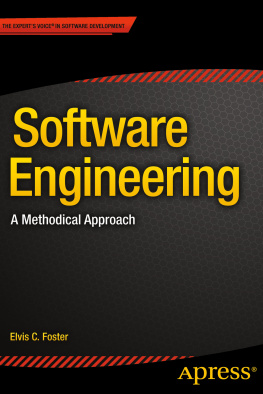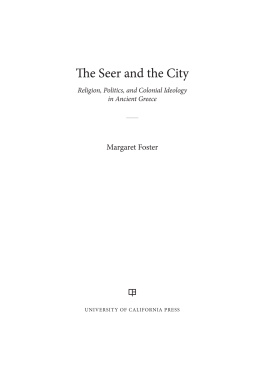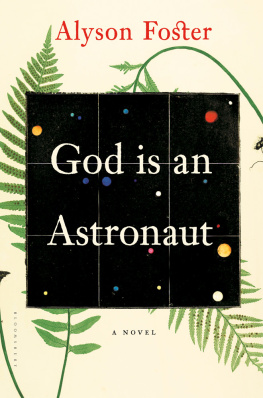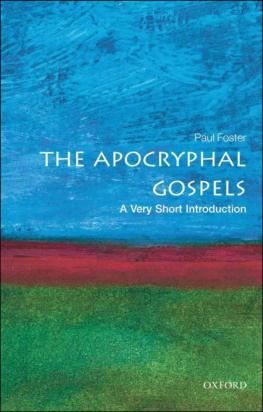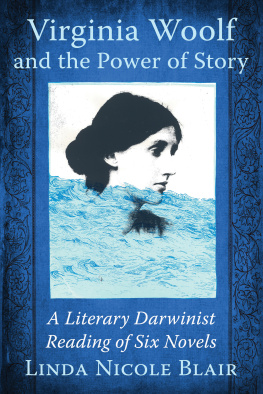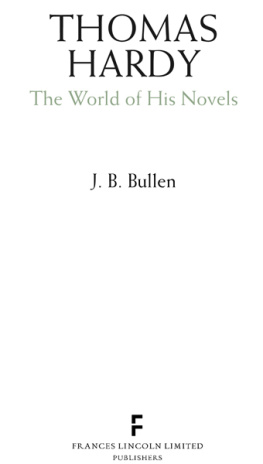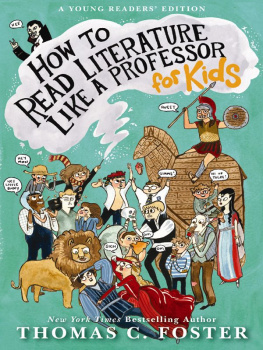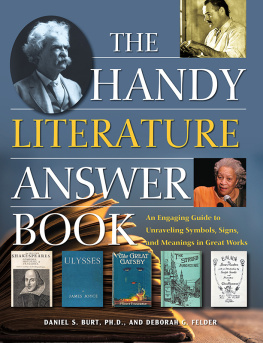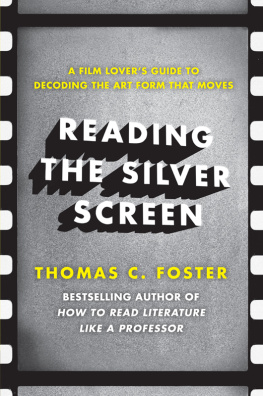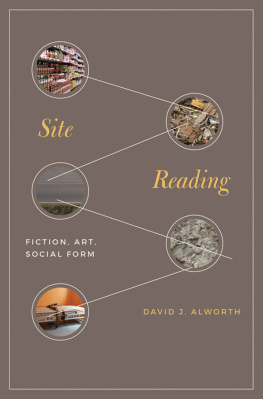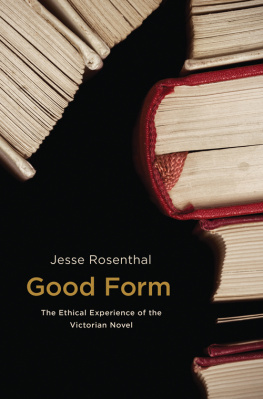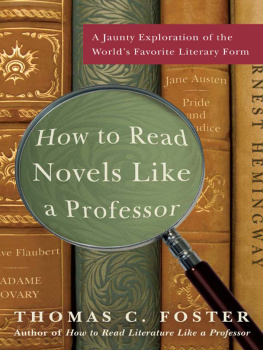About the Author
THOMAS C. FOSTER is a professor of English at the University of MichiganFlint, where he teaches classic and contemporary fiction, drama, and poetry, as well as creative writing and composition. In addition to Understanding Novels, he is the author of How to Read Literature Like a Professor and several books on twentieth-century British and Irish fiction and poetry. He lives in East Lansing, Michigan.
UNDERSTANDING
NOVELS
Also by Thomas C. Foster
How to Read Literature Like a Professor
UNDERSTANDING
NOVELS
Thomas C. Foster

1 3 5 7 9 10 8 6 4 2
Published by A & C Black Publishers 2009
First published 2008 by Harper Collins Publishers, NY
A & C Black Publishers Ltd
36 Soho Square,
London
W1D 3QY
978 1 4081 11062
2008, 2009 by Thomas C. Foster
A CIP catalogue record for this book is available from the British Library
All rights reserved. No part of this book may be reproduced or transmitted in any form or by any means electronic or mechanical, including photocopying, recording or by an information storage system without prior permission from the publisher.
Printed and bound in Great Britain by Caligraving Ltd, Suffolk
For Linda Wagner-Martin,
without whom the profession would be immensely poorer
IN WRITING THIS BOOK and indeed for years before, I have had the privilege of being surrounded by great people and have shown my gratitude by exploiting them shamelessly. I am deeply indebted to colleagues at the University of MichiganFlint and Michigan State University for many conversations, much advice, and editorial assistance. Professors Fred Svoboda, Alicia Kent, Steve Bernstein, Anjili Babbar, Jan Bernsten, and Leonora Smith have been unstinting in their contributions and their patience, which I have tried on many occasions. Their responses and suggestions inform this book in too many places to count. My profound thanks to Professor Jan Furman for her critical acumen, her generous support, and her willingness to express doubt regarding my flakier efforts. She is the bestand toughesteditor I could ever hope for. My thanks, too, to Diane Saylor and Nicole Bryant for observations, questions, and coffee.
It is no exaggeration to say that this book would not exist without my students. They never fail to teach me, and I am as obliged to them for their doubts as for their belief. They would probably be justified in charging me tuition. The same is true of readers of this books predecessor, How to Read Literature Like a Professor, especially those many who have taken the time to correspond. Their many comments, questions, and ideas have shaped the present text. More than one, in fact, requested early on that I write this very book; I should have heeded them sooner.
My thanks also to my editor, Rakesh Satyal, and the staff at HarperCollins, as well as to my agent, Faith Hamlin, and her assistant, Courtney Miller-Callihan. The process by which an idea becomes a manuscript and eventually a book is the furthest thing from mechanical, and at every stage, this one has fallen into the best of hands.
And finally, to my family I offer my most profound gratitude and love. My sons, Rob and Nate, have listened patiently and offered ideas and support when we were supposed to be fishing or hunting or building something, and I appreciate their efforts, and them, mightily. I have no idea how I could possibly have done any of this work over all these years without my wife, Brenda, offering her love and support. Her acceptance of my manifold shortcomings and idiosyncrasies is heroic, her tolerance for the slide-zone that is my workspace nothing short of saintly.
It remains only to be said that none of these excellent persons is in any way accountable for the shortcomings in these pages. The errors, as always, are purely mine.
Contents
WHEN HUCK AND JIM are floating south on their raft, where are we? How is it that we can identify with a being as monstrous, literally, as John Gardners Grendel? Have you ever been Lucy Honeychurch? Leopold Bloom? Humbert Humbert? Tom Jones? Bridget Jones? The novels we read allow us to encounter possible persons, versions of ourselves that we would never see, never permit ourselves to become, in places we can never go and might not care to, while assuring that we get to return home again. At the same time, the novel holds out its own possibilities, narrative miracles, and tricks that are rewards in themselves, seductions for unsuspecting and even canny readers.
Much of the continuing appeal of the novel lies in its collaborative nature; readers invest themselves in the characters stories, becoming actively involved in the creation of meaning. At the same time, they are rewarded by pleasures that are more intimate than the essentially vicarious genres of drama and film. That give-and-take between creator and audience starts in the first line, runs through the last word, and causes the novel to stay in our minds long after we close the cover.
And it is a real give-and-take. The novel begs to be read from its opening words, tells us how it would like to be read, suggests things we might look for. We readers decide whether well go with the program, even whether well read the book or not. We decide whether we agree with the author about whats important, we bring our understanding and imagination to bear on characters and events, we involve ourselves not merely in the story but in all aspects of the novel, we collude in the creation of meaning. And we carry the book with us and keep it alive, sometimes centuries after the author himself is dead. Active and engaged reading is critical to the life of the novel and rewarding and fulfilling in the life of the reader.
In 1967, the novel was in a bad way, or so it seemed. Two seminal essays by writers with distressingly similar names appeared in American publications, fortelling doom and gloom. The French critic and philosopher Roland Barthes published an essay called The Death of the Author in the journal Aspen. In that essay, Barthes places the whole responsibility for the construction of meaning and significance, that is to say the interpretive enterprise, on the reader, the writer (whom he prefers to call a scriptor) being little more than a conduit through which the accumulated culture pours its texts. Barthes is being more than a little impish in denying the author the quasi-divine authority he was accorded in earlier understandings of literary creation. But what he is chiefly supporting is the role of active and creative reading, something about which we will have occasion to discuss throughout the book. Perhaps more alarmingly, the American novelist John Barth published The Literature of Exhaustion in The Atlantic Monthly, in which he seemed to many readers to suggest that the novel was on its deathbed. What he in fact argued was that the novel as we had known it was pretty largely played out, the exhaustion of the essays title referring to exhausted possibilities. Fiction, he suggested, was going to have to find something new to do in order to reinvigorate itself. There was a lot of talk of the death of old ways in 1967, a lot of emphasis on newness, its signature event being the accumulation of outrageous humanity around the intersection of Haight and Ashbury streets in San Francisco.
What Barth seemed not to know (although with him, a lot of seeming is disingenuous) was that help was on the way. That same year, a novel was being published by a writer in Colombia and another was being composed by a writer in England, and they would offer ways forward from the apparent impasse. The English novelist John Fowles was composing
Next page

